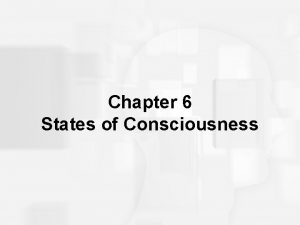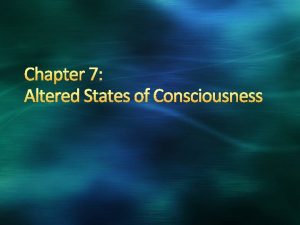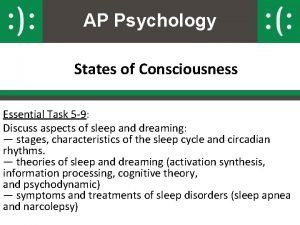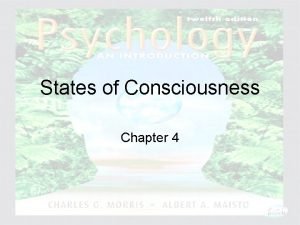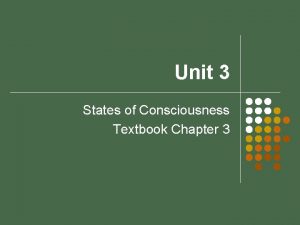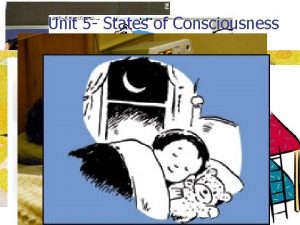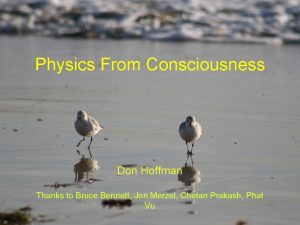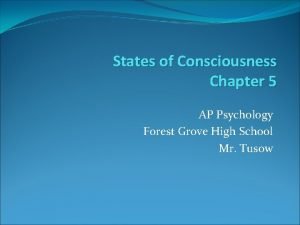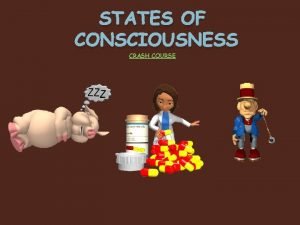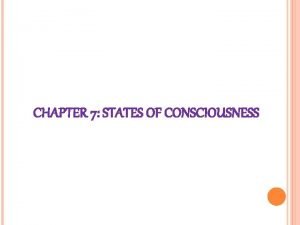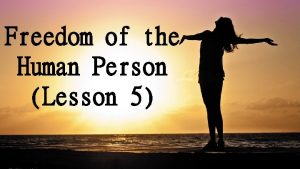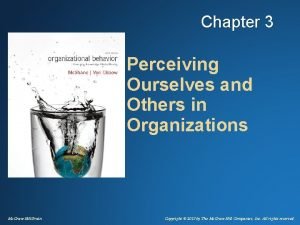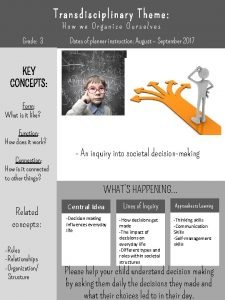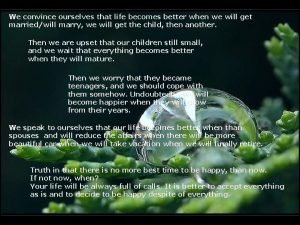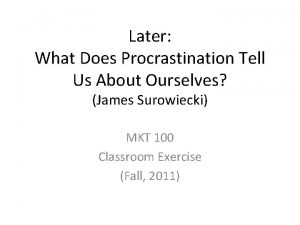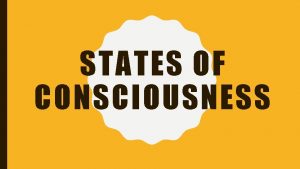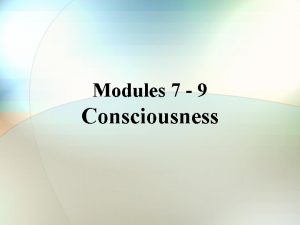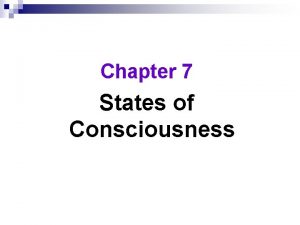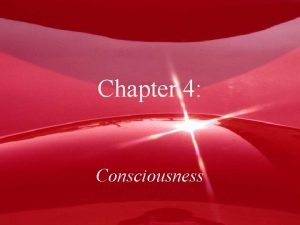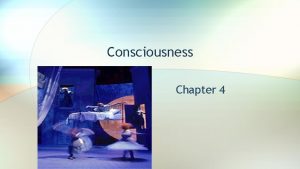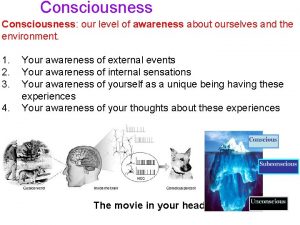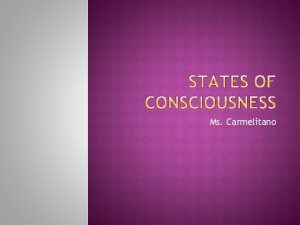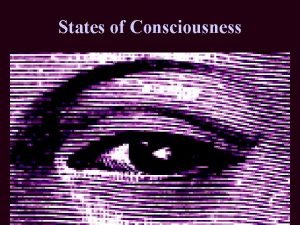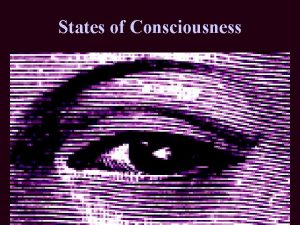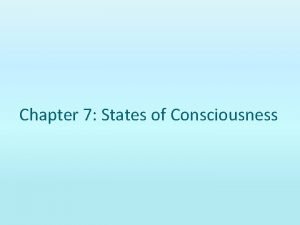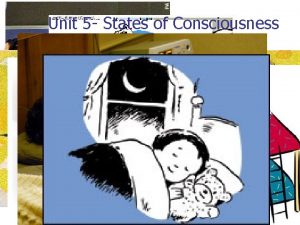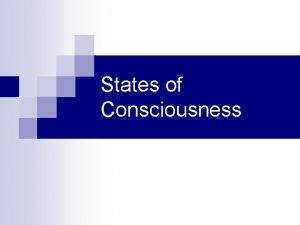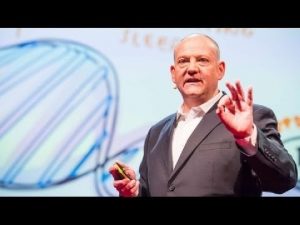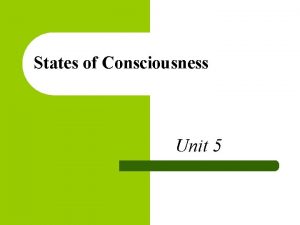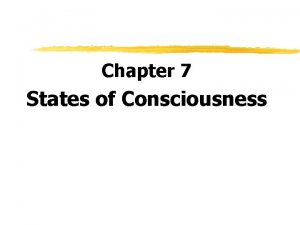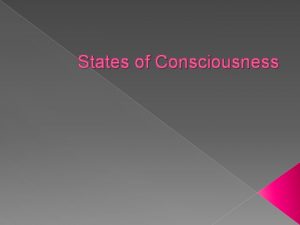States of Consciousness Consciousness our awareness of ourselves











































- Slides: 43

States of Consciousness

• Consciousness: our awareness of ourselves and our environment • Where does it come from? • No one knows. Possibly arises from the interaction of various brain functions • Does consciousness dictate our behavior or describe it?

The Nonconscious Process • The nonconscious mind is great at multitasking. Where the conscious mind has the ability to focus on just one task, the nonconscious mind has no such restrictions. • The conscious mind has to process things serially, while the nonconscious mind can handle many streams of information at the same time, called parallel processing. • Most of our brain processes take place outside of our awareness

What Consciousness Does Consciousness allows us to create a mental model of the world that we can manipulate. – Unlike other, simpler organisms, we are not prisoners of the moment: We don’t just act reflexively to stimulation. – Humans are the only animal with the ability to set goals.

Levels of the Nonconscious Mind • There are two levels of the nonconscious (subconscious) mind: preconscious and unconscious. • Preconscious memories: Information that is not currently in consciousness, but can be recalled voluntarily. • Unconscious: Cognition (thought) without awareness. – Involves levels of brain systems that range from autopilot to those which can have subtle influences on consciousness and behavior.

Freud’s View of Consciousness

What is Unconsciousness • A dictionary might define the term as being a loss of all consciousness, like when a person faints. • But in psychology, we define it a little differently. To show this, lets look at an example.

• Fill in the blanks to complete the word below: • D E F _ _ _

Answer • Using a technique called priming, psychologists can have some influence on the answer people give. • This idea of priming is similar to asking “leading questions” in court, or framing questions by asking them in a way which increases the likelihood of certain answers. • There were a number of possible answers to the example: defend, defeat, defect, defile, deform, defray, defuse and define. • There is an increased likelihood you chose define. Why?

Sleep and Dreams • Circadian Rhythm ▫ 24 -25 hour cycle (actually a little longer than 24 hours) • Night owls and early birds • Light- activates the suprachiasmatic nucleus (SCN) which causes the pineal gland to decrease melatonin • Biological clock can be adjusted- Daylight saving time?

• • • 70 -86: Def morning type 59 -69: Moderate morning type 42 -58: Neither type 31 -41: Moderate evening type 16 -30: Def evening type


Sleep Stages • Stage 1 (NREM 1) ▫ Beginning sleep ▫ May have hallucinations or dreamlike images ▫ You cannot remember the exact moment you fell asleep • Stage 2 (NREM 2)- 20 minutes ▫ Sleep spindles ▫ Easily awakened

• Stage 3 (NREM 3) – about 30 minutes ▫ ▫ Deep sleep Delta waves Hard to awaken Brain still processing stimuli • Stage 2 – again • Stage 1 - again

• REM Sleep ▫ Jagged brain waves ▫ Eye movement – signals dreams ▫ Brain stem blocks messages from motor cortex, leaving you mostly paralyzed • Whole sleep cycle lasts about 90 minutes • As night goes on, stage 3 becomes shorter and disappears; REM becomes longer





Why we sleep • Protection from predators • To incorporate memories • To repair neural connections and brain tissue – “closed for routine maintenance” • Growth

Sleep deprivation • • Sleep debt How much sleep do we need? How long can you go without sleep? FFI. Affects of sleep deprivation ▫ ▫ ▫ Fatigue Decreased concentration Irritability Depressed immune system Vulnerability (memory loss; obesity; hypertension)

Jet Lag

Accident frequency Less sleep, more accidents More sleep, fewer accidents 2, 800 2, 700 4, 200 2, 600 4000 2, 500 3, 800 2, 400 3, 600 Spring time change (hour sleep loss) Monday before time change Fall time change (hour sleep gained) Monday after time change

Sleep disorders • Insomnia- difficulty in falling asleep • Narcolepsy- inability to restrain sleep • Sleep apnea- person momentarily stops breathing during sleep, causing the person to awaken (which disrupts the sleep cycle)

Fig. 5 -11, p. 188

Why do we dream? • To fulfill our wishes/fantasies • To preserve memories • To repair neurons “closed for routine maintenance” • To make sense of neural static • To reflect cognitive development • Everyone dreams!

Dreams • Why do you have dreams that seem random? • Typically the first dream connects with events from the previous day. Later dreams tend to build on a theme in the previous dream. • Often times, the final dream is remembered most vividly, but has very little to do with the previous days events, or events that lay ahead.

What We Dream • Negative Emotional Content: 8 out of 10 dreams have negative emotional content. • Failure Dreams: People commonly dream about failure, being attacked, pursued, rejected, or struck with misfortune. • Sexual Dreams: Contrary to our thinking, sexual dreams are sparse. Sexual dreams in men are 1 in 10; and in women 1 in 30. 28

Truth About Dreams • Despite his theories there is no solid evidence to support Freud’s interpretations of latent dream content. • Dreams, do however, vary by age, gender and culture. • Children are more likely to dream about animals that are large and threatening, while adults dream more about pets. • Women are more likely to dream about men and women; men are more likely to dream about men.

Culture and Dreams • Many studies have supported theory that culture plays a large role in dream content. – Ghana: Attacking cows – Americans: Public nakedness – Mexican-Americans: Death • There is strong support for the idea that dreams reflect life events that are important to the dreamer.

Percentage Who Report Having Had These Dreams Men Women 1. Chased or pursued, 78% 83% not injured 2. Sexual experiences 85 73 3. Falling 73 74 4. School, teachers, 57 71 studying 5. Arriving too late, 55 62 e. g. , for a train 6. On the verge of falling 53 60 7. Trying to do something 55 53 repeatedly 8. A person living as dead 43 59 9. Flying or soaring 58 44 through the air 10. Sensing a presence 44 50 vividly 11. Failing a test 37 48 12. Being physically attacked 40 44 13. Being frozen with fright 32 44 14. A person now dead 37 39 as living 15. Being a child again 33 38

• Lucid dreams ▫ Make a habit of asking yourself throughout the day “am I dreaming” – eventually you will ask yourself this during a dream ▫ People who report having an average of one lucid dream a month have been shown to be more resilient when confronted with stressful events

Hypnosis • Is it real? • Suggestibility – 20% • Can you make someone do something they don’t want to do? • Pain?

0% (1) Not at all the same 25% (2) A little the same 50% (3) Between a little and much the same 75% (4) Much the same 90 +% (5) Almost exactly the same



Drugs • Depressants – reduce neural activity ▫ Alcohol ▫ Barbiturates – tranquilizers (like sleeping pills) ▫ Opiates – Opium. Morphine and heroin.

• Should the drinking age be lowered?

• Stimulants – excite neural activity ▫ ▫ ▫ Caffeine Nicotine Amphetamines Methamphetamines Cocaine Ecstasy

• Hallucinogens – distort perceptions ▫ LSD ▫ Marijuana

Near Death Experiences • Duality • Yes • No


 Our awareness of ourselves and our environment
Our awareness of ourselves and our environment Our awareness of ourselves and our environment
Our awareness of ourselves and our environment Our awareness of ourselves and our environment.
Our awareness of ourselves and our environment. Awareness of ourselves and our environment is:
Awareness of ourselves and our environment is: Horizontal mobility
Horizontal mobility Phallic stage of development
Phallic stage of development Perbedaan consciousness dan awareness
Perbedaan consciousness dan awareness Two states of mind hypnosis
Two states of mind hypnosis Privacy awareness and hipaa awareness training cvs
Privacy awareness and hipaa awareness training cvs 7 states of consciousness
7 states of consciousness Lesson quiz 7-1 altered states of consciousness
Lesson quiz 7-1 altered states of consciousness Chapter 7 altered states of consciousness
Chapter 7 altered states of consciousness Altered state of consciousness psychology
Altered state of consciousness psychology Ap psychology states of consciousness
Ap psychology states of consciousness 3 states of consciousness
3 states of consciousness Unit 5 states of consciousness answers
Unit 5 states of consciousness answers Unit 5 states of consciousness
Unit 5 states of consciousness Alpha waves ap psychology
Alpha waves ap psychology Crash course psychology consciousness
Crash course psychology consciousness Chapter 7 states of consciousness
Chapter 7 states of consciousness Rem sleep def
Rem sleep def Lesson 5 freedom of the human person answer key
Lesson 5 freedom of the human person answer key Southern vs northern states
Southern vs northern states Checks and balances dbq
Checks and balances dbq There were 11
There were 11 God our father christ our brother
God our father christ our brother Christ, be our light shine in our hearts
Christ, be our light shine in our hearts Our census our future
Our census our future Our future is in our hands quotes
Our future is in our hands quotes Marcus aurelius our life is what our thoughts make it
Marcus aurelius our life is what our thoughts make it Our life is what our thoughts make it
Our life is what our thoughts make it Thinking affects our language which then affects our
Thinking affects our language which then affects our We bow our hearts
We bow our hearts Money madness explanation
Money madness explanation Our census our future
Our census our future Perceiving ourselves and others in organizations
Perceiving ourselves and others in organizations We ask ourselves
We ask ourselves Songs of ourselves
Songs of ourselves Let's me introduce myself
Let's me introduce myself How we organise ourselves grade 3
How we organise ourselves grade 3 Seeing ourselves through the eyes of god
Seeing ourselves through the eyes of god We convince ourselves that life will be better
We convince ourselves that life will be better What does procrastination tell us about ourselves
What does procrastination tell us about ourselves Verbantes
Verbantes










